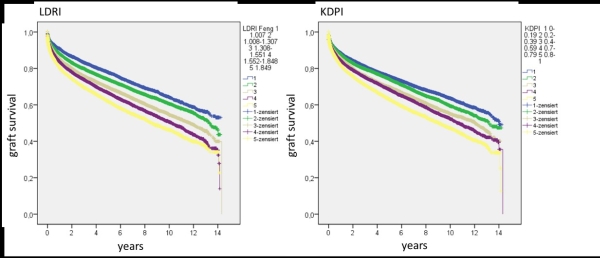Kidney Donor Profile Index (KDPI) is Not Inferior to Liver Donor Risk Index (LDRI) in Predicting Long-Term Liver Graft Survival
Surgery, Duke University, Durham, NC.
Meeting: 2018 American Transplant Congress
Abstract number: A298
Keywords: Liver transplantation
Session Information
Session Name: Poster Session A: Liver: MELD, Allocation and Donor Issues (DCD/ECD)
Session Type: Poster Session
Date: Saturday, June 2, 2018
Session Time: 5:30pm-7:30pm
 Presentation Time: 5:30pm-7:30pm
Presentation Time: 5:30pm-7:30pm
Location: Hall 4EF
Background: The primary aim of this study was to assess liver graft survival as a function of Kidney Donor Profile Index (KDPI), and compare the KDPI's predictive ability to Liver Donor Risk Index (LDRI).
Methods: The United Network of Organ Sharing (UNOS) Standard Analysis and Research (STAR) file was queried for adult patients (≥ 18 years of age) who underwent isolated deceased donor liver transplantation between 2002 and 2016. Primary endpoints were graft survival, patient death and graft. Values of KDPI and LDRI were divided into quintiles. Survival was calculated according to Kaplan Meier, and the log rank test was used to test for significance. Average KDRI and LDRI were calculated for each quintile and plotted against average graft survival to compare the linear regression coefficient.
Results: 72,963 patients were included in the study. Interclass correlations analysis showed an optimal consistency of both indices (average measure 0.849). Donor characteristics that were independent prognostic factors for graft survival included in KDPI were donor age, diabetes, cardiovascular accident as cause of death, donor height, donor weight, and positive HCV donor status (P < 0.05). Graft survival rates between KDPI quintiles was significant (P < 0.005). Linear regression analysis showed a similar correlation between KDPI with graft survival at 1-year, 5-year, and 10-years compared to LDRI (Figure 2: 10-yr R2 0.975 vs. 0.983, 5-yr R2 0.966 vs. 0.990, 1-yr R2 0.995 vs. 0.988).
Conclusion: In our analysis, KDPI was non-inferior in predicting long-term allograft outcomes compared to LDRI. Given that KDPI is readily accessible and does not dependent on variables unknown at the time of allocation, KDPI may represent a practical tool for liver donor selection. 

CITATION INFORMATION: Scheuermann U., Freischlag K., Gao Q., Yerxa J., Ezekian B., Davis R., Schroder P., Barbas A. Kidney Donor Profile Index (KDPI) is Not Inferior to Liver Donor Risk Index (LDRI) in Predicting Long-Term Liver Graft Survival Am J Transplant. 2017;17 (suppl 3).
To cite this abstract in AMA style:
Scheuermann U, Freischlag K, Gao Q, Yerxa J, Ezekian B, Davis R, Schroder P, Barbas A. Kidney Donor Profile Index (KDPI) is Not Inferior to Liver Donor Risk Index (LDRI) in Predicting Long-Term Liver Graft Survival [abstract]. https://atcmeetingabstracts.com/abstract/kidney-donor-profile-index-kdpi-is-not-inferior-to-liver-donor-risk-index-ldri-in-predicting-long-term-liver-graft-survival/. Accessed January 7, 2026.« Back to 2018 American Transplant Congress
